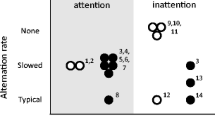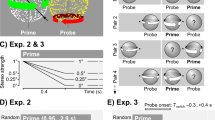Abstract
Simulation results of bistable perception due to ambiguous visual stimuli are presented which are obtained with a nonlinear dynamics model using perception–attention–memory coupling. Percept reversals are induced by attention fatigue and noise, with an attention bias which balances the relative percept duration. The dynamics of the attention parameter exhibits qualitative agreement with the eye blink rate variation [4]. Coupling of an attention bias to the perception state introduces memory effects leading to significant long range correlations of perceptual duration times as quantified by the Hurst parameter (H > 0.5). This prediction is in agreement with recent experimental results [1]. Deviations of the reversal time statistics from the Γ-distribution increase with decreasing memory time constant and attention noise. Mean perceptual duration times of 2 – 5 s are predicted in agreement with experimental results [7] if a feedback delay of ca. 40 ms is assumed which is typical for cortical reentrant loops.
Preview
Unable to display preview. Download preview PDF.
Similar content being viewed by others
References
Gao, J.B., Merk, I., Tung, W.W., Billok, V., White, K.D., Harris, J.G., Roychowdhury, V.P.: Inertia and memory in visual perception. Cogn. Process 7, 105–112 (2006)
Mandelbrot, B.B.: The fractal Geometry of Nature. German translation: Birkhäuser, pp. 265–270 (1991)
Fürstenau, N.: Modelling and Simulation of spontaneous perception switching with ambiguous visual stimuli in augmented vision systems. In: André, E., Dybkjær, L., Minker, W., Neumann, H., Weber, M. (eds.) PIT 2006. LNCS (LNAI), vol. 4021, pp. 20–31. Springer, Heidelberg (2006)
Ito, J., Nikolaev, A.R., Luman, M., Aukes, M.F., Nakatani, C., van Leeuwen, C.: Perceptual switching, eye movements, and the bus paradox. Perception 32, 681–698 (2003)
Blake, R., Logothetis, N.K.: Visual competition. Nature Reviews / Neuroscience 3, 1–11 (2002)
Orbach, J., Ehrlich, D., Heath, H.A.: Reversibility of the Necker Cube: An examination of the concept of satiation of orientation. Perceptual and Motor Skills 17, 439–458 (1963)
Borsellino, A., de Marco, A., Allazetta, A., Rinesi, S., Bartolini, B.: Reversal time distribution in the perception of visual ambiguous stimuli. Kybernetik 10, 139–144 (1972)
Hupe, J.-M., Rubin, N.: The dynamics of bistable alternation in ambiguous motion displays: a fresh look at plaids. Vision Research 43, 531–548 (2003)
Koch, C.: The Quest for Consciousness – A Neurobiological Approach, German Translation, Elsevier, München (2004)
Engel, A.K., Fries, P., Singer, W.: Dynamic Predictions: Oscillations and Synchrony in Top-Down Processing. Nature Reviews Neuroscience 2, 704–718 (2001)
Engel, A.K., Fries, P., König, P., Brecht, M., Singer, W.: Temporal binding, binocular rivalry, and consciousness. Consciousness and Cognition 8, 128–151 (1999)
Srinavasan, R., Russel, D.S., Edelman, G.M., Tononi, G.: Increased synchronization of magnetic responses during conscious perception. J. Neuroscience 19, 5435–5448 (1999)
Edelman, G.: Wider than the Sky. Penguin Books, pp. 87–96 (2004)
Kettani, H., Gubner, J.A.: A Novel Approach to the Estimation of the Long-Range Dependence Parameter. IEEE Trans. Circuits and Systems-II: Express Briefs 53, 463–467 (2006)
De Marco, A., Penengo, P., Trabucco, A., Borsellino, A., Carlini, F., Riani, M., Tuccio, M.T.: Stochastic Models and Fluctuations in Reversal Time of Ambiguous Figures. Perception 6, 645–656 (1977)
Merk, I.L.K., Schnakenberg, J.: A stochastic model of multistable perception. Biol. Cybern. 86, 111–116 (2002)
Poston, T., Stewart, I.: Nonlinear Modeling of Multistable Perception. Behavioral Science 23, 318–334 (1978)
Ditzinger, T., Haken, H.: A Synergetic Model of Multistability in Perception. In: Kruse, P., Stadler, M. (eds.) Ambiguity in Mind and Nature, pp. 255–273. Springer, Berlin (1995)
Levelt, W.J.M.: Note on the distribution of dominance times in binocular rivalry. Br. J. Psychol. 58, 143–145 (1967)
Lamme, V.A.F.: Why visual attention and awareness are different. Trends in cognitive Sciences 7, 12–18 (2003)
Tononi, G., Edelman, G.M.: Consciousness and Complexity. Science 282, 1846–1851 (1998)
Schuster, H.G., Wagner, P.A.: A Model for Neural Oscillations in the Visual Cortex: 1. Mean field theory and the derivation of the phase equations. Biol. Cybern. 64, 77–82 (1990)
Kelso, J.A.S., Case, P., Holroyd, T., Horvath, E., Raczaszek, J., Tuller, B., Ding, M.: Multistability and metastability in perceptual and brain dynamics. In: Kruse, P., Stadler, M. (eds.) Ambiguity in Mind and Nature, pp. 255–273. Springer, Berlin (1995)
Nakatani, H., van Leeuwen, C.: Transient synchrony of distant brain areas and perceptual switching in ambiguous figures. Biol. Cybern. 94, 445–457 (2006)
Itti, L., Koch, C.: Computational Modelling of Visual Attention. Nature Reviews Neuroscience 2, 194–203 (2001)
Robinson, D. (ed.): Neurobiology. Springer, Berlin (1998)
Fürstenau, N.: A chaotic attractor model of cognitive multistability. In: Proceedings IEEE 2004 Int. Conf. on Systems, Man and Cybernetics, IEEE cat. no. 04CH37583C, pp. 853–859 (2004)
Hillyard, S.A., Vogel, E.K., Luck, S.J.: Sensory gain control (amplification) as a mechanism of selective attention: electrophysiological and neuroimaging evidence. In: Humphreys, G.W., Duncan, J., Treisman, A. (eds.) Attention, Space, and Action, pp. 31–53. Oxford University Press (1999)
Nakatani, H., van Leeuwen, C.: Individual Differences in Perceptual Switching rates: the role of occipital alpha and frontal theta band activity. Biol. Cybern. 93, 343–354 (2005)
Watts, C., Fürstenau, N.: Multistable fiber-optic Michelson Interferometer exhibiting 95 stable states. IEEE J. Quantum Electron 25, 1–5 (1989)
Zhou, Y.H., Gao, J.B., White, K.D., Merk, I., Yao, K.: Perceptual dominance time distributions in multistable visual perception. Biol. Cybern. 90, 256–263 (2004)
Pitts, M.A., Nerger, J.L., Davis, T.J.R.: Electrophysiological correlates of perceptual reversals for three different types of multistable images. J. of Vision 7, 1–14 (2007)
Fürstenau, N.: Nonlinear dynamics model of cognitive multistability and binocular rivalry. In: Proceedings IEEE 2003 Int. Conf. on Systems, Man and Cybernetics, IEEE cat. no. 03CH37483C, pp. 1081-1088 (2003)
Lutzenberger, W., Preissl, H., Pulvermüller, F.: Fractal dimension of electroencephalographic time series and underlying brain processes. Biol. Cybern. 73, 477–482 (1995)
Dafilis, M.P., Liley, D.T.J., Cadusch, P.J.: Robust chaos in a model of the electroencephalogram: Implications for brain dynamics. Chaos 11, 474–478 (2001)
Burke, D.P., de Paor, A.M.: A stochastic limit cycle oscillator model of the EEG. Biol. Cybern. 91, 221–230 (2004)
Richards, W., Wilson, H.R., Sommer, M.A.: Chaos in percepts. Biol. Cybern. 70, 345–349 (1994)
Deco, G., Marti, D.: Deterministic Analysis of Stochastic Bifurcations in Multi-Stable Neurodynamical Systems. Biol. Cybern. 96, 487–496 (2007)
Wilson, H.R.: Spikes, Decisions, and Actions. Oxford University Press, Oxford (1999)
von der Malsburg, C.: The Coherence Definition of Consciousness. In: Ho, M., Miyashita, Y., Rolls, E.T. (eds.) Cognition, Computation, and Consciousnesss, pp. 193–204. Oxford University Press, Oxford (1997)
Meng, M., Tong, F.: Can attention selectively bias bistable perception? Differences between binocular rivalry and ambiguous figures. J. of Vision 4, 539–551 (2004)
Hamker, F.H.: A dynamic model of how feature cues guide spatial attention. Vision research 44, 501–521 (2004)
Lehky, S.R.: Binocular rivalry is not chaotic. Proc. R. Soc. Lond. B 259, 71–76 (1995)
Author information
Authors and Affiliations
Editor information
Rights and permissions
Copyright information
© 2007 Springer-Verlag Berlin Heidelberg
About this paper
Cite this paper
Fürstenau, N. (2007). A Computational Model of Bistable Perception- Attention Dynamics with Long Range Correlations. In: Hertzberg, J., Beetz, M., Englert, R. (eds) KI 2007: Advances in Artificial Intelligence. KI 2007. Lecture Notes in Computer Science(), vol 4667. Springer, Berlin, Heidelberg. https://doi.org/10.1007/978-3-540-74565-5_20
Download citation
DOI: https://doi.org/10.1007/978-3-540-74565-5_20
Publisher Name: Springer, Berlin, Heidelberg
Print ISBN: 978-3-540-74564-8
Online ISBN: 978-3-540-74565-5
eBook Packages: Computer ScienceComputer Science (R0)




